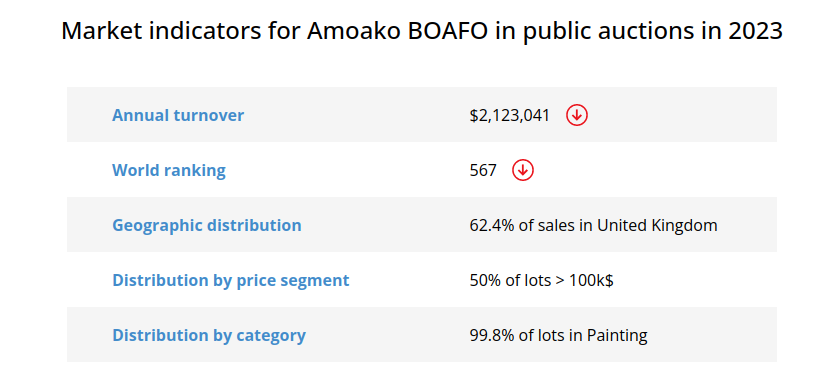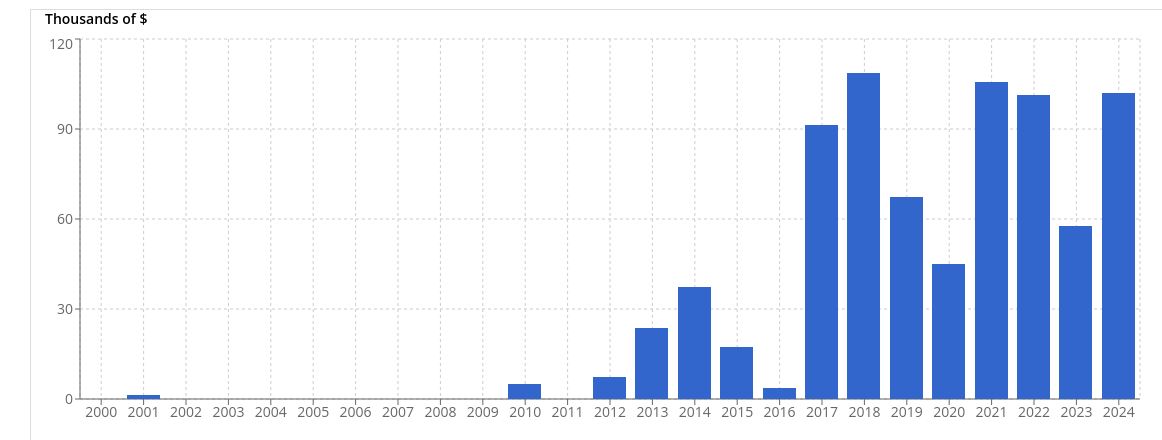The current market for African contemporary art
[23.07.2024]Exchanges involving African art have slowed in line with the general slowdown of the global art market, but the galleries, dealers and organizations that encourage and promote African art are actively pursuing their ambitions to structure the offer and establish a strong presence for African and/or black artists in the global market.
After a tumultuous 2023 marked by conflicts in Ukraine, Palestine and elsewhere, the art market has continued running at a slow pace in 2024. Auction sales have seen a significant decline, with almost half the number of 7-digit results (-45%) compared with Q1 2023, leading to a spectacular 36% drop in global art auction sales turnover.
The growth of the African art market has clearly slowed, just like China’s art market slowed after the beginning of the 2000s. However, this phase could prove beneficial for African art by providing a necessary pause to purge the speculative trends of previous years and identify emerging artists. This period of transition is likely to give way to a phase of consolidation, supported by continued demand and strong commitment from museums, galleries and auction houses who work tirelessly to promote African creation on the global stage.
From euphoria to repositioning
In less than a decade, a revolution has taken place. Interest in African art and its diaspora has become a major trend in the global art market, radically transforming the artistic and cultural landscape. The phenomenon began between 2016 – when Kerry James Marshall set a sales record at $2 million – and 2018, when his painting Past Times crossed the $20 million mark at Sotheby’s in New York. Thereafter, demand for works by African and/or black artists really took off.
A handful of artists such as Njideka Akunyili CROSBY, Michael ARMITAGE, Toyin Ojih ODUTOLA, Otis Kwame Kye QUAICOE, Kudzanai-Violet HWAMI have become the new rising stars of the art market, sometimes reaching prices exceeding the million-dollar threshold in major sales. The socio-political events of the last four years, marked by the tragic death of George Floyd and the resurgence of the Black Lives Matter movement, have intensified the attention given to Africa and its diaspora, particularly among curators and cultural programmers.
Acquisitions by major museums like the Pompidou Center, the Tate Modern and the MoMA have bolstered the institutional presence of African and/or black artists. In the auction sphere, we have seen a real boom reflecting a rush to acquire works by these artists. In 2022 more than 2,700 such works changed hands, nearly double the number sold two or three years earlier. The period was also marked by the powerful emergence of Amoako BOAFO, whose record went from one to three million dollars in Hong Kong between 2020 and 2021 symbolizing the spectacular breakthrough of Contemporary African artists on the international scene.

Behind these impressive figures there was also a lot of speculation. Some buyers seized the opportunity of the bull market to make rapid capital gains, causing the prices for several artists to inflate exponentially, sometimes too quickly. After the peak in 2022 the fall was brutal for some of these artists: Aboudia DIARRASSOUBA, an American-Ivorian artist whose works sold for more than $500,000 in 2022, saw his annual auction turnover divided by four in 2023. Similarly, Isshaq ISMAIL from Ghana, whose works fetched more than $300,000 in China and the UK in 2022, failed to fetch more than $19,000 at auction during the first quarter of 2024. This type of market volatility is often very challenging for emerging artists. After the phase of euphoria, buyers will need to adopt a more strategic and measured approach to build a stronger market.
Evolution of Ismail’s Position in the Global Ranking Based on His Auction Sales Revenue

While at first glance the established artists seem less exposed to market fluctuations, the reality is quite different: prices have reached such heights that even works by the most renowned Contemporary artists are stalling. Boafo’s and Anatsui’s markets perfectly illustrate this trend: despite their fame, their works have become so expensive that collectors have become rarer. This year, nearly a quarter of their works offered at auction have remained unsold, a situation that was unthinkable just two years ago and suggesting that buyers have become more selective and cautious in their artistic investments.
Caution and patience required
The market for African art appears to have stumbled in March of this year. While the Cape Town auction house, Strauss & Co. sale successfully sold two works by Alexis PRELLER for $230,000 and $180,000 on 19 March, two days later at a Sotheby’s sale in London (21 March) a masterpiece by the same artist failed to reach its low estimate of around $300,000 and was bought in. Indeed, in the current climate, nothing is certain, especially when the prices are high. Despite this, the overall outcome of Sotheby’s sale of Modern and Contemporary African art was positive, with three quarters of the lots selling and two artists, Olaolu SLAWN and Frédéric BRULY BOUABRÉ, setting new auction records well above estimates, respectively at $40,000 and $80,000. So, although big results are no longer being hammered, records are still being set for established artists whose works are offered at reasonable prices. Regarding the younger generation – Kwesi Botchway, Gideon Appah, Cornelius Annor, and others – the demand remains buoyant, but more selective. The works are chosen with care and the bidding rarely goes much beyond low estimates.
Evolution of Frédéric Bruly Bouabré’s Auction Sales Revenue (copyright Artprice.com)

This period of market slowdown offers interesting purchasing opportunities, particularly for fans of new artists. Young African artists who appear at auction for the first time are finding buyers at very affordable prices, like Joseph Munyao Mutuku BARAKA (1998) whose large canvas Good Morning (2022) cost just $3,550 during a Sotheby’s online sale last March.
Having become more cautious and selective, collectors are today seeking interesting works at fair prices. This period of transformation of the market for African art is therefore not gloomy, but rather exhilarating and full of promises. The market is reshaping itself in the face of a multitude of exciting challenges, while its influence is continuing to expand globally.
Article Artprice by Artmarket published in our partner magazine Diptyk.




 32.1
32.1
